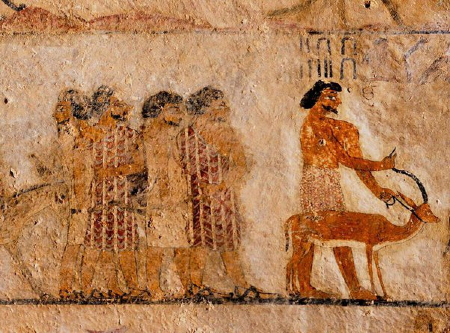We ask you, humbly: don't scroll away.
Hi readers, it seems you use Catholic Online a lot; that's great! It's a little awkward to ask, but we need your help. If you have already donated, we sincerely thank you. We're not salespeople, but we depend on donations averaging $14.76 and fewer than 1% of readers give. If you donate just $5.00, the price of your coffee, Catholic Online School could keep thriving. Thank you.Help Now >
Sanctuary
FREE Catholic Classes
A consecrated place giving protection to those fleeing from justice or persecution ; or, the privilege of taking refuge in such consecrated place.
The right of sanctuary was based on the inviolability attached to things sacred, and not, as some have held, on the example set by the Hebrew cities of refuge . It was recognized under the Code of Theodosius (399) and later by that of Justinian. Papal sanction was first given to it by Leo I, about 460, though the first Council of Orange had dealt with the matter in 441.
The earliest mention of sanctuary in England was in a code of laws promulgated by King Ethelbert in 600. The right of asylum was originally confined to the church itself, but in course of time its limits were extended to the precincts, and sometimes even to a larger area. Thus, at Beverley and Hexham, the boundaries of sanctuary extended throughout a radius of a mile from the church, the limits being marked by "sanctuary crosses", some of which still remain.
In Norman times there were two kinds of sanctuary in England, one belonging to every church by prescription and the other by special royal character. The latter was considered to afford a much safer asylum and was enjoyed by at least twenty-two churches, including Battle, Beverley, Colchester, Durham, Hexham, Norwich, Ripon, Wells, Winchester, Westminster, and York.
A fugitive convicted of felony and taking the benefit of sanctuary was afforded protection from thirty to forty days, after which, subject to certain severe conditions, he had to " abjure the realm", that is leave the kingdom within a specified time and take an oath not to return without the king's leave. Violation of the protection of sanctuary was punishable by excommunication.
In some cases there was a stone seat within the church, called the "frith-stool", on which it is said the seeker of sanctuary had to sit in order to establish his claim to protection. In others, and more commonly, there was a large ring or knocker on the church door, the holding of which gave the right of asylum. Examples of these may been seen at Durham cathedral, St. Gregory's, Norwich, and elsewhere.
The ecclesiastical right of sanctuary ceased in England at the Reformation, but was after that date allowed to certain non-ecclesiastical precincts, which afforded shelter chiefly to debtors. The houses of ambassadors were also sometimes quasi-sanctuaries.
Whitefriars, London (also called Alsatia), was the last place of sanctuary used in England, but it was abolished by Act of Parliament in 1697. In other European countries the right of sanctuary ceased towards the end of the eighteenth century.
Join the Movement
When you sign up below, you don't just join an email list - you're joining an entire movement for Free world class Catholic education.
-

-
Mysteries of the Rosary
-
St. Faustina Kowalska
-
Litany of the Blessed Virgin Mary
-
Saint of the Day for Wednesday, Oct 4th, 2023
-
Popular Saints
-
St. Francis of Assisi
-
Bible
-
Female / Women Saints
-
7 Morning Prayers you need to get your day started with God
-
Litany of the Blessed Virgin Mary
Biblical Lost Alphabet Traced Back to Ancient Canaanite Civilization
-

What are the Health Benefits of Grass-Fed Beef for Your Body and Mind?
-

Rise Above Poverty is Empowering Children and Families Through Education and Compassion
-
Artists and Leaders Rally to Preserve the Traditional Latin Mass
-
Republicans Demand Answers Over Army Training Slide Labeling Pro-Life Groups as Terrorist Threats
Daily Catholic
 Daily Readings for Wednesday, July 24, 2024
Daily Readings for Wednesday, July 24, 2024 St. John Boste: Saint of the Day for Wednesday, July 24, 2024
St. John Boste: Saint of the Day for Wednesday, July 24, 2024 Prayer for Travelers: Prayer of the Day for Wednesday, July 24, 2024
Prayer for Travelers: Prayer of the Day for Wednesday, July 24, 2024- Daily Readings for Tuesday, July 23, 2024
- St. Bridget of Sweden: Saint of the Day for Tuesday, July 23, 2024
- A Child's Prayer to Mary: Prayer of the Day for Tuesday, July 23, 2024
![]()
Copyright 2024 Catholic Online. All materials contained on this site, whether written, audible or visual are the exclusive property of Catholic Online and are protected under U.S. and International copyright laws, © Copyright 2024 Catholic Online. Any unauthorized use, without prior written consent of Catholic Online is strictly forbidden and prohibited.
Catholic Online is a Project of Your Catholic Voice Foundation, a Not-for-Profit Corporation. Your Catholic Voice Foundation has been granted a recognition of tax exemption under Section 501(c)(3) of the Internal Revenue Code. Federal Tax Identification Number: 81-0596847. Your gift is tax-deductible as allowed by law.









 Daily Readings for Wednesday, July 24, 2024
Daily Readings for Wednesday, July 24, 2024 St. John Boste: Saint of the Day for Wednesday, July 24, 2024
St. John Boste: Saint of the Day for Wednesday, July 24, 2024 Prayer for Travelers: Prayer of the Day for Wednesday, July 24, 2024
Prayer for Travelers: Prayer of the Day for Wednesday, July 24, 2024

